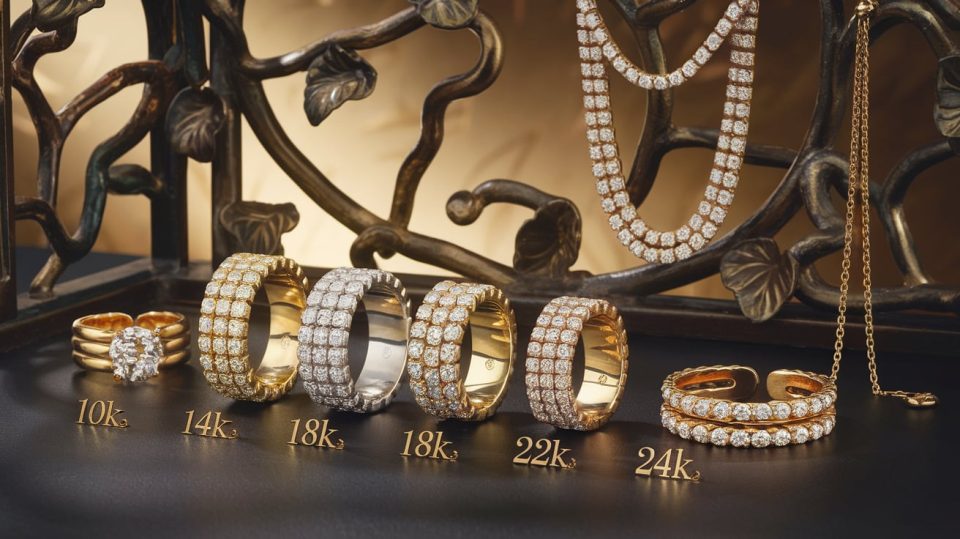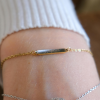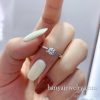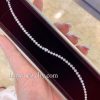When choosing gold jewelry, one of the biggest questions that comes up is: “Which is better, 14K, 18K, or 24K gold?” This question matters because gold comes in various karat weights, each with distinct characteristics and qualities that suit different preferences, lifestyles, and budgets. In this blog, we’ll dive deep into the differences between 10K, 14K, 18K, 22K, and 24K gold, to help you choose the right type of gold for your needs.

Understanding Gold Purity: What Do Karats Mean?
Gold purity is measured in karats (K), with 24K representing pure gold, or 99.9% gold content. The higher the karat number, the more gold the alloy contains. However, pure gold is also soft, which makes it prone to scratches and wear over time. To improve durability, jewelers mix gold with other metals, such as copper, silver, or nickel, which creates different karat types.
| Karat | Gold Content (%) | Durability | Common Uses |
|---|---|---|---|
| 10K | 41.7% | High | Rings, Bracelets (everyday wear) |
| 14K | 58.3% | High | Rings, Earrings, Necklaces (everyday wear) |
| 18K | 75% | Moderate | Engagement Rings, Fine Jewelry |
| 22K | 91.6% | Moderate-Low | Heirloom Pieces, Traditional Jewelry |
| 24K | 99.9% | Low | Special Jewelry, Collectibles |
10K Gold: The Budget-Friendly Option
10K gold is made up of 41.7% gold and 58.3% alloy. It is the least pure of all gold types and has a pale, slightly metallic appearance. This karat is ideal for those looking for durability at an affordable price.
- Pros: Very durable, highly resistant to scratches and bending, more affordable.
- Cons: Has a slightly duller color compared to higher karats, less luxurious appearance.
Best For: Everyday jewelry such as rings and bracelets, especially for those on a budget or with an active lifestyle.
14K Gold: The Popular Choice for Everyday Wear
14K gold is a popular option because it balances durability with purity. Comprising 58.3% gold, it has a warm tone while being more resistant to wear and tear than higher karats, making it suitable for everyday jewelry.
- Pros: Good balance between durability and appearance, affordable, ideal for frequent wear.
- Cons: Not as vibrant as 18K or 24K gold.
Best For: Rings, earrings, necklaces, and bracelets worn regularly. Is 14K or 18K gold better for everyday wear? 14K gold is often preferred for daily use because it withstands regular wear and tear better than higher karats.
18K Gold: The Ideal Balance of Luxury and Practicality
18K gold contains 75% pure gold and is often considered the “sweet spot” for those who want a luxurious appearance without compromising too much on durability. With a rich, warm hue, 18K gold is commonly used in fine jewelry and engagement rings.
- Pros: Rich color, less prone to tarnish than lower karats, luxurious appearance.
- Cons: Prone to scratches and may not be suitable for highly active lifestyles.
Best For: Engagement rings, special occasion jewelry, and those seeking a luxury feel. When asking, “Which is better, 18 carat or 24 carat gold?” 18K gold provides a more durable option while still maintaining a rich gold appearance.
22K Gold: High Purity and Traditional Charm
With 91.6% pure gold content, 22K gold is primarily used in traditional jewelry, particularly in cultures that value high gold content in heirloom pieces. While it is more durable than 24K, it’s still relatively soft compared to 10K and 14K gold.
- Pros: Rich color, valuable for traditional and investment purposes, high resale value.
- Cons: Prone to scratching, less durable for everyday wear.
Best For: Traditional and cultural jewelry, heirloom pieces. Which gold karat is best? For sentimental and cultural pieces, 22K is ideal due to its value and high purity.
24K Gold: The Purest Form of Gold
24K gold is 99.9% pure, making it the most valuable and luxurious option. However, its softness limits its suitability for everyday jewelry as it is prone to bending and scratches.
- Pros: Purest form, vibrant yellow color, high intrinsic value.
- Cons: Extremely soft, easily damaged, not practical for regular wear.
Best For: Collectibles, special occasion jewelry, investment pieces. If you’re wondering, “Which is better, 14K, 18K, or 24K gold?” 24K gold may be appealing for its purity, but it lacks the durability of 14K and 18K for daily wear.
Comparing 14K, 18K, and 24K Gold: Which Is Better?
Which is better, 14K, 18K, or 24K gold? It ultimately depends on your priorities. Here’s a breakdown to help you choose:
- Durability: 14K is the most durable, ideal for active lifestyles. 18K is a close second but is slightly softer due to higher gold content. 24K is the softest and not suitable for daily wear.
- Color and Appearance: 24K has the richest yellow color, followed by 18K, which has a balanced and luxurious tone. 14K has a slightly paler look but is still warm.
- Cost: 14K is the most affordable, while 24K is the most expensive. 18K strikes a middle ground.
Which Gold Is Best for Daily Use?
For daily use, durability is key, making 10K and 14K gold the top choices. Which gold is best for daily use? Most people find that 14K gold offers a nice balance between durability and aesthetics, making it a suitable option for everyday jewelry.
Choosing the Right Gold for Different Types of Jewelry
Engagement and Wedding Rings
14K and 18K are the most common choices for rings that will be worn daily. Is 14K or 18K gold better for everyday wear? 14K is often preferred for its durability, but 18K is popular for those wanting a richer color.
Earrings
18K and 22K are common in earrings, as they’re less exposed to wear. However, those with sensitive skin may prefer 18K, which has less alloy content.
Necklaces and Bracelets
Both 14K and 18K work well, but if you want a piece that’s worn close to the skin and looks vibrant, 18K is a luxurious choice.
How to Care for Different Karat Gold
Regardless of the karat, gold jewelry should be handled with care to maintain its appearance and prevent damage:
- Cleaning: Use mild soap and water or a specialized gold cleaner. Avoid harsh chemicals.
- Storage: Store gold jewelry in a soft cloth or jewelry box to prevent scratches.
- Maintenance: Regularly polish your jewelry and consider professional cleaning for higher karat pieces, especially 18K and 24K.
Which is better, 18 carat or 24 carat gold?
18K is more durable and practical for daily use, while 24K is prized for its purity and rich color, making it ideal for special pieces.
Is 14K or 18K gold better for everyday wear?
14K gold is typically better for everyday wear due to its high durability, while 18K offers a more luxurious appearance but is softer.
Which gold is best for daily use?
14K gold is generally considered the best for daily use, balancing durability with a warm, attractive color.
Which gold karat is best?
The best karat depends on your needs. 14K is best for durability, 18K for a blend of luxury and practicality, and 24K for high purity.
Final Thoughts: Which Gold Karat Is Right for You?
When choosing gold jewelry, consider your lifestyle, budget, and personal preferences. If you’re looking for jewelry you can wear daily, 10K and 14K gold are practical choices that offer resilience. If you prefer a touch of luxury, 18K gold offers a good balance between beauty and durability. For those seeking the purest form of gold for special occasions, 22K and 24K pieces are unmatched in richness and value.
Ultimately, “Which is better, 14K, 18K, or 24K gold?” depends on what matters most to you in terms of durability, appearance, and purpose. Choose the gold that resonates with your style and needs, and you’ll have a timeless piece that you can cherish for years to come.









